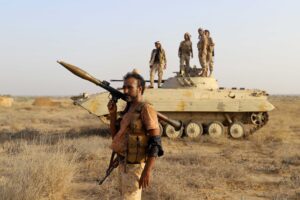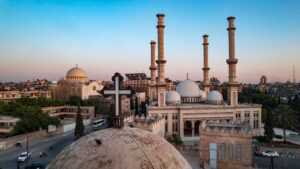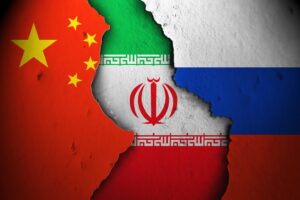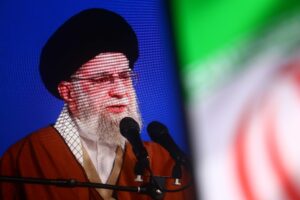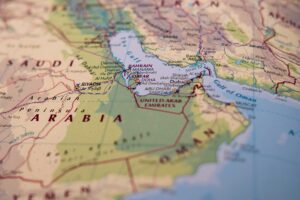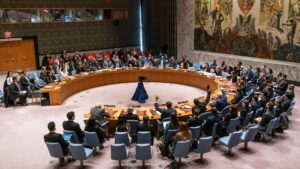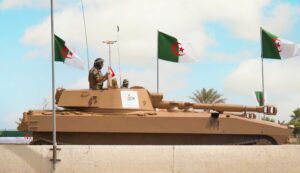“It’s a shame for a nation […] [that] they have a 35 or 40% voter turnout […]. It’s a shame for them. It’s clear that people do neither exhibit trust nor attention or hope in their political system. Prior to these elections […], they interviewed […] citizens, asking them whom they would vote for. They replied: ‘What’s the purpose, what’s the difference? To nobody!’ And this is precisely how it unfolded.”
None other than Iran’s Supreme Leader Ali Khamenei assessed low electoral participation in the U.S. in particular and Western countries in general in a 2001 speech. Following the historically low turnout in Iran’s early March elections, the video of his speech has understandably gone viral among Iranians[i].
According to official figures released by Iran’s Interior Ministry (following a unusual three-day delay[ii]), among the 61.1 million eligible voters, 25 million or almost 41% cast their ballots on the 1st March in elections for the Parliament and the Assembly of Experts (with almost half in the capital city of Tehran, where one-ninth of Iranians live), including at least 5% voting void and blank. The elections marked yet another low voter turnout after the 2020 parliamentary elections saw 42.6% voting.[iii]
On 5th March, Khamenei hailed the elections, emphasizing that “the Iranian nation did a jihad and fulfilled their social and civil duties”, having defeated “enemies” who tried to dissuade them from voting.
Official figures vs. real voter turnout
Given widespread popular disillusion with the country’s entire political establishment, real voter turnout may be considerably lower.
Official figures echoed the 40% figure that the Fars News Agency, affiliated with the Islamic Revolutionary Guard Corps (IRGC), had announced earlier.[iv] However, given widespread popular disillusion with the country’s entire political establishment, real voter turnout may be considerably lower—probably half of the above figure. According to a survey conducted by a government center[v], only 30%, with around 22% in Tehran Province and only 15% in the city of Tehran, participated in the elections. These figures may more accurately reflect social reality in Iran rather than the official statistics. Two incumbent parliamentarians, Jalal Rashidi Koochaki[vi] and Somayeh Mahmoudi[vii], have reported cases where the national identification of citizens was used to cast votes in the elections despite the non-participation of the actual ID holders. Another group of voters, albeit much smaller, may have been coerced by the state by means of warnings about professional penalties, for example, in the case of teachers as reported by some media outlets, or through incentivizing people such as soldiers, who were offered four days off.[viii] All of this could potentially substantiate the suspicion that there is a discrepancy between voter engagement and the turnout figures reported.
Reformists and the March elections
In the tightly controlled political landscape of Iran, where the establishment usually suppresses opposition and silences dissenters, the so-called reformist faction stands as the only group of critics within the regime itself that has been permitted to engage in political activities. However, the reformist camp has experienced a significant decline in influence and credibility, particularly since the nationwide protests at the turn of 2017-18. During these protests, the emergence of the slogan “reformist, hardliner, the game is over” reflected a growing sentiment within Iranian society that dismissed the distinction between reformists and the regime, viewing the entire political system as irredeemable.
The reformist camp [...] refrained from officially organizing a campaign. This was rooted in a recognition of their diminished standing among the populace.
In the context of the March elections, the reformist camp demonstrated a noticeable reticence about actively participating. It refrained from officially organizing a campaign or endorsing candidates for the elections, signaling a strategic withdrawal from the political fray. This was rooted in a recognition of the reformists’ diminished standing among the populace, as they acknowledged the need to rebuild their legitimacy. Mohammad Khatami, the former president of Iran who is known as the leader of the reformist movement, made a symbolic gesture by abstaining from voting for the first time. This was intended to convey the reformists’ desire to recalibrate their agenda and redefine their role in Iranian politics. Meanwhile, voices within the reformist camp have criticized the electoral process, suggesting that the government’s portrayal of the elections as a success is unfounded. For instance, prominent reformist journalist Ahmad Zeydabadi dismissed[ix] the significance of voter turnout figures, arguing that the government would tout any number as a triumph, however low. Mahmood Sadeghi, a former MP, highlighted[x] the inconsistency in the government’s narrative, contrasting its previous attributions of low turnout to the COVID-19 pandemic with its current celebration of a “victory.” On his part, Abbas Abdi, another influential reformist figure, speculated[xi] that the government might have manipulated the announced voter turnout rate.
While the reformist camp, including Khatami, has disavowed any movements that challenge the entire political system of the Islamic Republic, its stance appears increasingly disconnected from the prevailing demand among Iranians for a transition to a genuine democracy.
Therefore, reformists’ dilemma underscores a fundamental rift between their own objectives and the aspirations of broader society. While they aim to operate within the confines of the Islamic Republic, hoping to effect change from within, probably not least for the sake of their own factional benefit, Iranians are questioning the viability of reform. This stark divergence highlights the challenging path that lies ahead for the reformist camp.
Political, economic, and international ramifications
The implications of the March elections in Iran are profound and multifaceted, meriting a detailed examination across three distinct yet interconnected dimensions—those of the political, economic, and international.
First, the trend of decreasing voter turnout is a stark indicator of the growing disillusionment among Iranians. The fact that this is the third election in a span of four years where the majority abstained from voting is indeed a critical sign. Historically, Iran boasted voter turnouts above 60%. The decline is not merely a statistic; it represents a deepening legitimacy crisis for the Islamic Republic. Such a crisis is particularly significant in a society as dynamic and politically aware as Iran’s. Low voter engagement provides a morale boost to protesters and opposition groups, who may see this as evidence of a silent majority that opposes the current regime. This perception could catalyze more coordinated and widespread protests, challenging the government’s stability. While the regime has traditionally relied on its security apparatus to maintain control, the ongoing erosion of its legitimacy poses a complex medium-term challenge that may not be easily surmountable, especially considering the advanced age of the current Supreme Leader and the impending leadership transition.
Second, the potential economic ramifications of the vote could be severe for Iranians. In the lead-up to elections, there’s a noticeable pattern where the government attempts to stabilize prices to curry favor with the electorate. However, following an election bringing about another instance of historically low turnout, there may be less political will within the government to address economic grievances—possibly even as a punitive measure against a population that has shown signs of defiance and whose further immiseration the regime may tolerate in the hope of thwarting political activism. This approach could, however, exacerbate already dire economic conditions, marked by inflation and unemployment, fueling further discontent among the masses. The government’s probable focus on bolstering its security forces and ideological entities might come at the expense of much-needed economic reforms, further deepening the divide between state and society.
Iranian people’s protests—both through street protests and abstention from the elections—send a strong signal to the international community.
Third, the international dimension of Iran’s March elections is critical yet uncertain. Iranian people’s protests—both through street protests and abstention from the elections—send a strong signal to the international community, particularly Western governments, about the evolving political landscape in the country. The challenge for the West is to interpret these signals accurately and recalibrate its policies toward Iran accordingly.[xii] While Iranians lean toward a democratic transition, the West appears to be in a quandary about how to effectively engage with or influence the situation. The elections could be a watershed moment, prompting Western capitals to rethink their engagement strategies with Iran, moving beyond rhetoric toward instead implementing policies that would align with the aspirations of Iranian civil society. However, the precise nature of this recalibration and whether it will translate into meaningful policy changes on the ground, remains an open question.
Conclusion: Developments at the societal and élite levels
The recent elections have underscored two critical developments. First, the boycott campaign has led to the lowest voter turnout since the inception of the Islamic Republic. MP Mahmood Nabavian, who secured the position of MP in Tehran, received only around 597,000 votes, representing[xiii] merely 6% of the eligible voters in the city. This trend is consistent across other cities, where victorious candidates represent only 4% to 7% of the eligible population in their respective regions. Ham-Mihan, a reformist daily, interprets[xiv] this low turnout as a silent protest from individuals who choose not to engage in street demonstrations, expressing their dissent by abstaining from voting.
Second, despite the Guardian Council’s disqualification of numerous potential government critics, the election evolved into a contest among different factions of principalists, all aligned with the Islamic Republic’s center of power, i.e. Khamenei’s Office and IRGC. The primary list featured the incumbent parliamentary speaker, Mohammad Ghalibaf, alongside his allies, rooted in a coalition between centrist principalists and the Paydari Front, a more radical faction. However, other contenders affiliated with the Paydari Front, such as Amir-Hossein Sabeti and Hamid Rasaee (or Rasai), compiled their own lists and secured the second and third positions in Tehran, respectively. Ghalibaf was placed fourth with approximately 447,000 votes, a notable decline from his over one million votes and first-place finish in Tehran during the 2020 parliamentary elections. This outcome marks a considerable setback for him and his coalition, reflecting the shifting dynamics within Iran’s political landscape.
In fact, the success of the Paydari Front suggests that predominantly individuals with a radical ideological alignment with the Islamic Republic participated in the elections. Figures such as Nabavian, Sabeti, and Rasaee, known for their extremist stances—for example, rejecting negotiations with the West, sustaining enmity with the U.S., more ferociously implementing hijab laws, and restricting internet freedom—underscore this trend. The election of other members or candidates affiliated with the Paydari Front in Tehran and other major cities hints at a potentially significant shift. Meanwhile, Etemad, a reformist daily, posits that the widening gap between citizens and the government could foster radicalism.
However, it is critical to note that the Parliament’s role in Iran’s major policy decisions is relatively limited, as it often operates under the guidance of Iran’s real centers of power. For instance, in 2020, the current Parliament, now introduced as less hardline, endorsed a bill urging the Rouhani administration to adopt a nuclear escalation strategy, a move lauded by Khamenei, indicating his influence over parliamentary decisions. Therefore, predicting a shift toward a more hardline Parliament and significant policy changes may be premature. Instead, the more acute question revolves around how the Islamic Republic’s center of power will leverage Parliament to legitimize its strategies. With the current leadership hesitating to intensify domestic or international tensions and a heightened awareness of a legitimacy crisis due to another historically low voter turnout, a significant policy shift may pose risks to the Islamic Republic’s survival. According to Ahmad Zeyd-Abadi[xv], a reformist journalist, the Iranian leadership’s decisions are not heavily influenced by the Parliament’s composition; even if radical figures dominate. He notes that the predetermined policy shifts are likely to be implemented even if radical figures are not in the Parliament.
Thus, the recent election results should not be interpreted as a shift toward a new dichotomy within Iran’s political landscape, pitting centrist hardliners (or fundamentalists) against radical hardliners (or extremists). For years, many were willing to highlight a hardliner versus moderate antagonism, which was finally rejected by the Iranian people with the winter 2017/18 nationwide uprising.[xvi]
Indeed, decision-making is likely to remain predominantly under the control of the Supreme Leader, his Office, and the IRGC, with other institutions and individuals playing roles as demanded from them. In other words, at least for now, it is not probable that a more risk-taking of radical revolutionaries will take over the helm of the state, potentially making decisions that may ultimately jeopardize regime stability or even survival.
[i] Twitter/X (2024). Lettres de Teheran, 3 March 2024, retrieved from lettres de Teheran az X-en: „Vidéo devenue virale en Iran après le scrutin du vendredi. Khamenei, chef du régime islamique, avait déclaré il y a 12 ans qu’un taux de participation de 40 % était une honte, signe que les électeurs ne faisaient pas confiance à leur gouvernement. Aujourd’hui, le régime considère… https://t.co/g1AyHPtwwi” / X (twitter.com).
[ii] Twitter/X (2024). Mohammad Hasan Najmi, retrieved from: Mohammad Hasan Najmi az X-en: „این یک بدعت جدید از سوی وزارت کشور بود که هیچ آمار نوبهای از میزان مشارکت در سراسر کشور اعلام نکرد. در چندین استان هیچ آماری از نرخ مشارکت اعلام نکردند. واقعا شرمآور بود که تنها برخی مقامات استانها آمار دست و پا شکسته ارائه کردند! وزارت کشور گویا هیچ اعتقادی به شفافیت ندارد!” / X (twitter.com).
[iii] Fathollah-Nejad, A. (2020). “Where’s Iran Going?”, OrientXXI, 14 April 2020, retrieved from: Where’s Iran Going? – Ali Fathollah-Nejad (orientxxi.info).
[iv] Asriran (2024). Election campaign failed, voter turnout was 40%, March 2024, retrieved from: Election campaign failed, voter turnout was 40% (asriran.com).
[v] Fararu (2024). “The latest survey about the elections”, March 2024, retrieved from: فرارو | جدیدترین نظرسنجی درباره انتخابات؛ مشارکت تهران فقط ۱۵ درصد! (fararu.com).
[vi] Fararu (2024). “Controversial claim of MP about the elections”, March 2024, retrieved from: فرارو | ادعای جنجالی نماینده مجلس درباره انتخابات؛ پدیده کد ملی وارداتی! (fararu.com).
[vii] Etemad Online (2024). “Many people don’t know that their national IDs were used for voting”, March 2024, retrieved from: ادعای نماینده شهررضا: بسیاری از افراد نمیدانند با کد ملی آنها رایگیری شده! (etemadonline.com).
[viii] Asriran (2024). “Four days’ leave for soldiers to encourage participation in the elections”, March 2024, retrieved from: https://www.asriran.com/fa/news/947285/%DB%B4-%D8%B1%D9%88%D8%B2-%D9%85%D8%B1%D8%AE%D8%B5%DB%8C-%D8%AA%D8%B4%D9%88%DB%8C%D9%82%DB%8C-%D8%A8%D9%87-%D8%B3%D8%B1%D8%A8%D8%A7%D8%B2%D8%A7%D9%86-%D8%A8%D8%B1%D8%A7%DB%8C-%D9%85%D8%B4%D8%A7%D8%B1%DA%A9%D8%AA-%D8%AF%D8%B1-%D8%A7%D9%86%D8%AA%D8%AE%D8%A7%D8%A8%D8%A7%D8%AA.
[ix] Telegram (2024). Ahmad Zeid Abad, 1 March 2024, retrieved from: https://t.me/ahmadzeidabad/3754.
[x] Twitter/X (2024). Mahmood Sadeghi, 1 March 2024, retrieved from: محمود صادقی az X-en: „دوره قبل که مشارکت ۴۲.۵ درصد اعلام شد گفتند علتش کرونا بوده، حالا رسیدن به زیر این نصاب برایشان یک پیروزی است!” / X (twitter.com).
[xi] Twitter/X (2024). Abbas Abdi, 2 March 2024, retrieved from: عباس عبدی az X-en: „تصور کنید روزی برسد که حسین رضازاده دوپینگ کند و با زدن وزنه ۱۰۰ کیلویی از شدت خوشحالی سر از پا نشناسد.” / X (twitter.com).
[xii] Fathollah-Nejad, A. (2023). “The Islamic Republic in Existential Crisis”, EUISS, 29 June 2023, retrieved from: https://www.iss.europa.eu/content/islamic-republic-existential-crisis.
[xiii] Asriran (2024). “Winner in Tehran election represents 6% of the people”, March 2024, retrieved from: روزنامه جمهوری اسلامی : نفر اول انتخابات تهران نماینده ۶ درصد مردم است / در برگههای رأی بجای نام کاندیداها قیمت کالاها را نوشته اند، مسئولان معنی این کارها را درک می کنند؟ (asriran.com).
[xiv] Asriran (2024). “According to reformist newspaper, reason for decrease in participation is protest by not voting”, March 2024, retrieved from: علت کاهش مشارکت از نظر روزنامه اصلاح طلب: بعضی معترضان به وضع موجود به خیابان نمی آیند؛ اعتراض شان را با رای ندادن اعلام می کنند (asriran.com).
[xv] Telegram (2024). Ahmad Zeid Abad, 5 March 2024, retrieved from: https://t.me/ahmadzeidabad/3769.
[xvi] Fathollah-Nejad, A. (2020). “The Islamic Republic of Iran four decades on: The 2017/18 protests amid a triple crisis”, Brookings, 27 April 2020, retrieved from: https://www.brookings.edu/articles/the-islamic-republic-of-iran-four-decades-on-the-2017-18-protests-amid-a-triple-crisis/.




